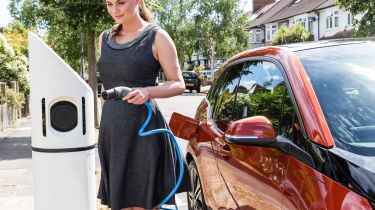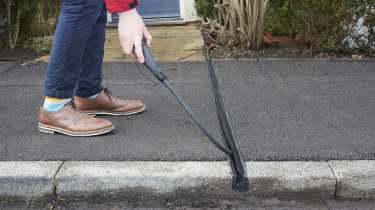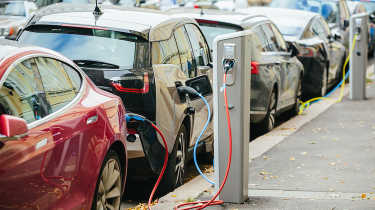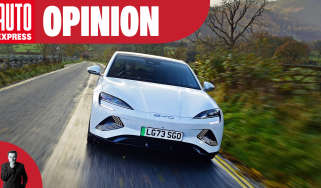Electric car charging at home with no driveway: rules, tips and cross-pavement options
Don’t have a driveway? We show you how it’s still possible to charge your electric car at home

An electric car makes perfect sense if you have access to a driveway and can install a home EV wallbox charger to take advantage of low-cost EV electricity tariffs. But what if you don’t have a driveway or off-street parking space? Thankfully, there are now various electric car charging solutions available for households without a driveway.
Electric cars are now a common sight on UK roads with the Society of Motor Manufacturers and Traders reporting that more than one in five new cars registered in the first part of 2025 were powered by electricity.
When it comes to the EV transition, the UK has a fundamental issue because more than a third of UK homes don’t have a driveway, rising to almost two thirds in towns and cities. This raises the question: where on earth then will people charge their cars?
According to ZapMap, there were over 86,000 electric vehicle charging points available at the end of September 2025, up from 73,000 at the end of 2024. While many public charging points are able to charge an EV quicker than a dedicated home wallbox, they are often a lot more expensive than plugging in at home.
Cross-pavement charging solutions have been devised to ensure that those without a driveway or who rely on on-street parking can still reap many of the benefits of switching to an EV.
In this article, we’ll explain all of the different options available to electric car buyers, as well as the intricacies of the OZEV home charger grant and the laws surrounding cable management.
If you’re lucky enough to have a driveway, we also have a more general guide to EV charging, which explores the ins and outs of plugging in at home and away.
What are the cross-pavement charging rules?
In a world full of health and safety laws, you won’t be surprised to hear that there are several rules and restrictions surrounding cross-pavement charging. For starters, you cannot simply trail your cables across the pavement in order to plug your car in. Under Section 162 of The Highways Act 1980, it is forbidden to place rope or wires on a public highway unless one has taken all the necessary steps to mitigate danger and/or injury.
In some circumstances, those wishing to charge their car from across the pavement may also need to seek permission from the local council or authority.
Some of the cross-pavement charging solutions available involve modifying the pavement itself to create a channel or gully for the charging cable to run through and may require approval under Section 50 of the New Roads and Street Works Act 1991. Many councils have dedicated pages covering this on their respective websites.
It’s likely you’ll also need to apply for planning permission to install a private wallbox or a ground-mounted charger serving an on-street parking area, unless a Local Development Order (LDO) is in place. This also extends to those living in listed buildings, but it’s best to check with your local authority.
If you also need to upgrade your electricity infrastructure, you will need to gain approval from your local Distribution Network Operator (DNO).

What cross-pavement solutions are there?
There are several cross-pavement charging solutions available, depending on your situation and budget.
Charging cable protectors
At the most basic and cost-effective (think a few hundred pounds) end of the market are cable protectors from companies such as Edion.
In effect these are plastic housings that can be placed on the pavement and are typically strong enough that someone can stand or walk over them without damaging the cable inside.
These protectors usually don’t require council permission to install and comply with the aforementioned Highways Act 1980, because they are clearly marked by streaks of bright yellow. Their typically trapezoidal design also makes them much less of a trip hazard.
Charging cable channels and gullies
Next up are cable gullies from the likes of Kerbo Charge, Pavecross and Charge Gulley.
Unlike cable protectors which sit on top of the pavement, gulleys require digging into the pavement to install a channel through which the cable can pass, whilst remaining flush with the pavement.
As you can expect, gulleys are usually a lot more expensive to fit (budget around £1,000) and require permission from the council, although firms such as Kerbo Charge will typically do the liaising for you.
Charging cable arms
Then at the more elaborate end of the scale are cross-pavement arms, such as the ChargeArm or the ChargeBridge from Nodum – the latter of which is not on public sale yet.
Rather than trail cables across the pavement, charging arms haul them over the pavement, thus reducing the amount of obstruction.
In most cases, charging cable arms require planning permission, as well as deep pockets because something like a ChargeArm can cost one-and-a-half to two times the price of the equivalent cable gully.
Are there any cross-pavement charging grants?
If you’re looking to install a cross-pavement charging solution, you’ll be glad to learn that the government’s Office of Zero Emissions Vehicles (OZEV) currently offers the ‘Electric vehicle chargepoint infrastructure’ grant.
You can get 75% off the cost to buy and install an EV charger or cross-pavement charging solution, up to a maximum of £350. Be warned though as there are a few caveats.
First and foremost, the only people eligible are those living in a flat, or with dedicated on-street parking or those living in rented accommodation. The previous charge point grant for those living in a house with a driveway has now been discontinued.
To qualify, you must also seek permission from the local council to install whatever it is you’re looking to put in place. You must, as you’d expect, also be the registered keeper of an EV or plug-in hybrid vehicle and/or have at least six months left on your lease deal.
Anyone looking to take advantage of this grant will need to act quickly though as the deadline for applications is set to end in March 2026.

On-Street Residential Solutions
Alongside the on-street charging solutions mentioned above, a number of local authorities are working with communities to install charging points and residential solutions to encourage the transition to electric vehicles.
These EV charge points are unlike the regular chargers you’ll find at larger public charging stations, but are typically located discreetly in lamp-posts, kerbside pillars or even old street cabinets.
You’ll typically need to bring your own cable to use these charge points, and the charging speeds will vary depending on the area. But they remain a great option if you can’t afford and/or don’t have the means to install a cross-pavement solution.

Other EV charging solutions if you don’t have a driveway
If you don’t have access to a driveway, are unable to install a cross-pavement charging solution, or can’t take advantage of any residential or community chargers mentioned above, there are a few other options you should consider.
Utilise EV changing sharing apps
If you’re on friendly terms with your neighbours and they have a driveway and wallbox or an on-street parking solution already installed, consider using an EV charging sharing app.
All scheduling arrangements and payments are sorted within the app, so all you have to do is schedule a slot ahead of time with the host and plug in your EV when you arrive.
Once the session is over, payment will be sent to the host for the electricity used via the app. Charging using an EV sharing app will cost more than it would if you had your own wallbox and EV specific tariff, but not as much as using a public charger.
Workplace charging
If you’re fortunate enough to have access to an EV charge point at your place of work, this could be a convenient and cost-effective way of charging your car, especially if your employer covers the cost of the electricity.
Using a workplace charger means you can charge your car while you’re at work and don’t need to rely on the public charging network when commuting day-to-day.
Free public EV charge points
The number of free public charge points is dwindling to say the least, but as of May 2025, there were just over 1,800 charging devices which were still free to use according to ZapMap.
It’s worth keeping an eye out for free public charge points as many of the ones still available are in convenient locations like the car parks of pubs, restaurants and hotels. Just be sure to check the parking restrictions before plugging in.
Low emissions at an equally low cost! These are the cheapest electric cars on sale...
Find a car with the experts




